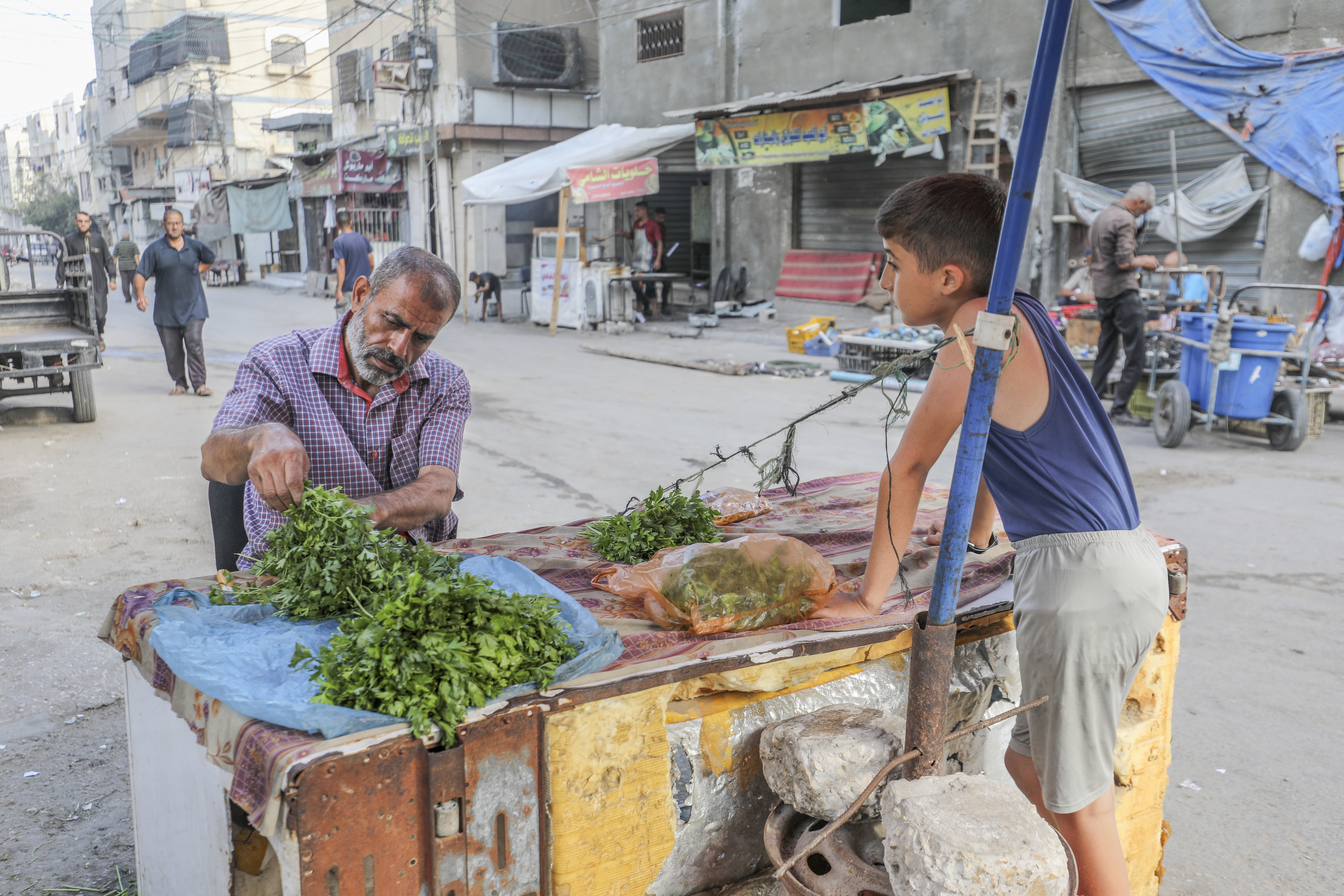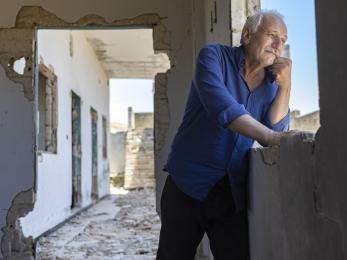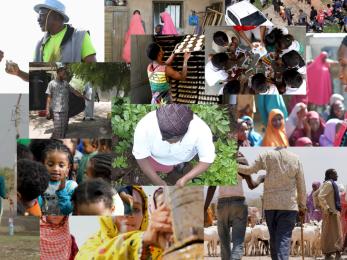Community connection: Top 10 photos of 2024
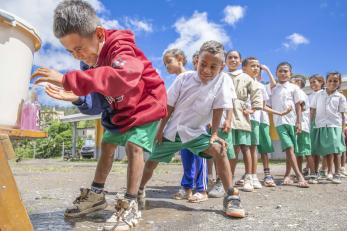
One evening in early October, my family and I were sitting down to dinner when we suddenly felt our building shake, followed by deep, resounding blasts from outside. We rushed to the window, and there, above Amman, we saw streaks of light — missiles, drones, and interceptors exploding in the sky.
My work often takes me to conflict zones, so it wasn’t my first experience with war, but it was the first time it felt so close to my home in Jordan. As I watched my eight-year-old daughter take in the scene, I thought about friends and colleagues in Gaza and Lebanon and was reminded of the families I meet in my line of work who live with this kind of fear and uncertainty every day.
Just weeks earlier, I had returned from Ukraine, where I met families using art therapy to cope with the trauma of displacement caused by the war. Throughout the year, our team met participants in communities across Kenya, Syria, Nigeria, Ethiopia, and Timor-Leste. Looking back at our top photos of the year, I see connections between them; our shared humanity, our care for our children, our neighbours and each other. In a world where uncertainty seems to grow by the day, these connections have never felt more important.
While this year has shown us that disaster and conflict can strike without warning, Mercy Corps is responding to emergencies, delivering relief, while helping families recover in more than 40 countries around the world. From supplying urgent food kits in Gaza to supporting livelihoods in Colombia and Mauritania, our work reached more than 37.6 million people in 2024. I’m honored to share some of the moments we captured of our teams in action working alongside communities, the stories behind the photos, and more about Mercy Corps’ commitment to bold solutions that make lasting change possible.
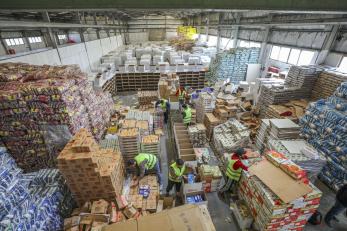
It has been frustrating to be living in Jordan, right next door to Gaza, but unable to travel there to help or photograph Mercy Corps’ work. I was glad to spend time at this warehouse in Amman, documenting our staff and volunteers as they packed 1,300 food kits that were flown into Egypt and driven over the border to be distributed to families in Gaza. The team worked with great focus, knowing how important this shipment was to people’s survival.
Since October 2023, Mercy Corps has partnered with local organisations to deliver more than 12,000 food and 9,000 hygiene kits to thousands of families in areas where it is safe to distribute supplies. Mercy Corps has also provided electronic cash assistance to over 23,000 households so families may purchase the essential items that are available, though provisions are limited.
Earlier this year, our team in Gaza was able to overcome the challenges of bombardment and multiple forced displacements to resume our youth engagement programme by adapting to current safety considerations and resource limitations. As of November 2024, Mercy Corps has led mental health support and basic education activities at well-being camps, reaching 4,500 children and young people along with nearly 1,500 parents and caregivers. Despite the difficulties and uncertainty in delivering aid to Gaza, Mercy Corps is committed to persevering in our efforts to provide life-saving assistance now and to help rebuild lives and communities when a ceasefire is reached.
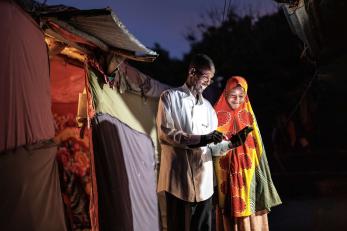
This beautifully lit photo was captured by our Regional Photographer Jjumba Martin. He recalled the assignment in Sheder Refugee Camp in eastern Ethiopia: “I had traveled here to document a new solar mini-grid, which was installed by Mercy Corps to provide a sustainable power solution to over 1,000 households in the camp and the host community. I met 58-year-old Farhan* with one of his daughters at their compound, not far away from the new solar plant. His situation highlighted challenges faced by displaced populations regarding access to reliable energy sources, especially in the context of long-term displacement. The family of 14 fled Somalia because of al-Shabaab raids and had lived here for more than 10 years. They had relied on diesel generators for electricity, which offered only two operational hours per day at high costs. Now, he enjoys the convenience of charging his phone at his home.”
Ethiopia is home to over 4.7 million forcibly displaced people, and it is estimated that less than 7% of those people have constant access to energy. Through Mercy Corps’ Enter Energy initiative, our team partnered with an Ethiopian company that provides renewable energy solutions for underserved communities. Along with the more than 1,000 households who have access to prepaid renewable energy, 24 hours a day—at half the cost of what they used to pay for two hours of diesel-powered electricity—over 300 refugee businesses within the camp are connected to the grid, supporting more consistent incomes and boosting livelihoods.
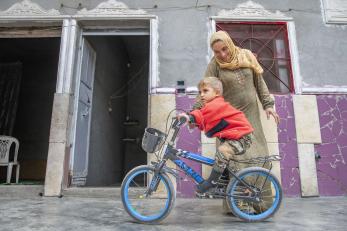
Hiba* helps her son Khaled* ride a bicycle in the courtyard of their home in the Aldaraeia neighbourhood in northern Syria, where Hiba and her family have lived for 15 years. For years, the only way residents could obtain water was by digging a hole in the street to tap into a sporadic municipal pipe—a precarious solution that was often insufficient and supplied contaminated water. Mercy Corps completed a new water system for the neighbourhood, reaching over 20,000 people, and now Hiba and her family have a tap in their home providing access to safe, dependable water. Hiba expressed happiness in having access to water, and her joy was clear as she played with her son. The connection between them comes through in this photo. She told me, “Water is life, and the introduction of this water system has undeniably breathed new life into our community.”
In 2024, Mercy Corps reached more than 8.2 million people across 29 countries to improve access to clean water. As the effects of climate change and conflict limit the availability of clean water, the need for lasting, scalable solutions grows in Syria. With the recent historic moment in Syria pointing to a transformative future, it’s imperative to ensure access to clean water for long-term recovery.
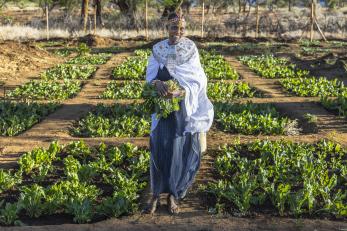
I was excited to meet Selina in the late afternoon as she harvested kale from the community garden in northern Kenya. The late afternoon sunlight bathed the grid of dark green kale in a warm glow, matching Selina’s smile. Along with 20 other women, Selina works at the community garden as part of the Nailepunye Girls’ group, supported by Mercy Corps. The women receive training like climate-resilient farming, nutrition, hygiene, and basic literacy. Selina has learned to read and write, which has helped in sessions on nutrition where she was informed of healthy recipes to cook for her family, using the fresh vegetables they grow in their garden.
Mercy Corps works with communities, local organisations, and authorities to develop comprehensive and inclusive programmes to improve nutrition and food security—and has reached more than 9.4 million people in 2024. By strengthening the foundation of well-being, people can focus on building more secure and sustainable futures.
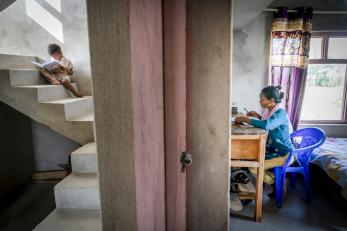
Our Regional Photographer Niranjan Shrestha created this photo of Mamata preparing to visit neighbouring villages as her son read books on the stairs of their home. Mamata is a volunteer for a Mercy Corps programme that helps communities in increasing their resilience to natural disasters. “I was truly impressed by the composition of this photo,” Niranjan recalls, “as well as the way the child and his mother are deeply focused on their respective tasks, supporting each other in harmony. Mamata not only manages her family responsibilities but also stands out as both a supporter and messenger for her community. Her role in preparing people ahead of disasters is remarkable, especially given the personal challenges she faces in her daily life.”
In regions where communities must contend with frequent crises brought on by climate change, disaster preparedness helps people focus on their daily lives by giving them confidence to manage potential challenges while also setting the groundwork for sustainable long-term recovery. Mercy Corps reached more than 8.6 million people with programmes supporting more climate resilience within communities.

For several years, violence over politics, religion, and culture had roiled David’s hometown in northern Nigeria. So when David opened his cobbler workshop in 2019, he also began to mentor young men from his village. He acts as an older brother to some of them, holding them accountable for their schoolwork and teaching them to cobble shoes so they’re able to use that skill to earn a living. For those that aren’t interested in cobbling, he tries to find out what they’re passionate about and helps them pursue their goals.
In 2022, David began participating in a Mercy Corps peacebuilding programme where he has learned additional skills to help bring a more stable future to his community. This photo highlights David’s strength, while the rows of shoes on the wall, strong colours, and soft light coming through the open door of his shop combine appealing textures and composition.
David is among the more than 11.5 million people that Mercy Corps reached with our peace and good governance programmes across 29 countries. Conflict and violence threaten the positive change communities work toward, and our programming makes every effort to reduce these risks through community dialogues and civic engagement.
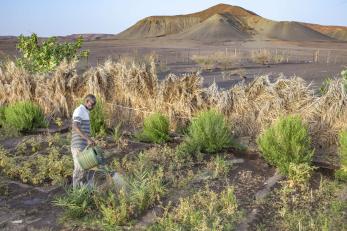
In southeastern Mauritania, Barke waters crops at a farming cooperative that was established in 2008. Ghadima, the name of the farm co-op, means “the old one.” This was one my the most remote assignments I have had for Mercy Corps, requiring a full two days of driving across the Sahara Desert to reach the community. This farm was striking, as it seemingly rose up out of empty desert, in a region known as “The Hodhs.” Beyond the fence, there is sand as far as the eye can see.
As part of Mercy Corps’ Nafoore programme, participants received business and technical training, seeds, and equipment for the farm. Co-op members have seen increased productivity with their range of crops including cowpeas, tomatoes, and eggplants. Mercy Corps programmes like Nafoore use a holistic approach that addresses the different, yet interconnected, needs of communities. In Mauritania, participants are not only increasing their own food security through the co-op farm but improving their livelihoods, which help to set up a more stable future for all.
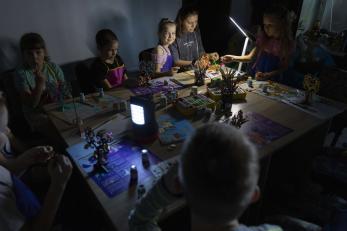
During a blackout in Mykolaiv, located in southern Ukraine, I was led to the basement of Mercy Corps’ partner organisation, Prospektyva. As I walked down the dark stairs following air raid sirens, the last thing I expected was to be greeted by Hanna’s huge, welcoming smile. Hanna* (in the pink shirt), and her mother Yuliia*, were in the middle of an art therapy session hosted by Prospektyva.
When the war began, their family was forced to stay in an underground shelter for five months. Yuliia and her two youngest daughters recently began attending classes at the community centre. The children feel safe and happy while participating in the art therapy programme, a welcome respite from the fear they experience at home due to regular air raid sirens and explosions. The girls have made friends with other children in the programme, helping them feel more connected to their community.
Since the escalation of the war in 2022, Mercy Corps has supported more than 750,000 people affected by the conflict in Ukraine and neighbouring countries. Through cash aid, small business grants, emergency kits, Mercy Corps collaborates with local organisations to meet the specific needs of communities displaced by the war.
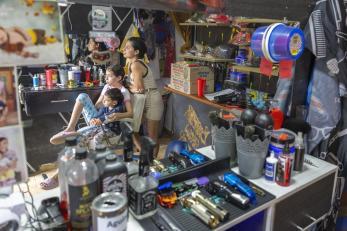
In 2023, Maria* and her family moved to Medellin, Colombia with hopes of opening a barbershop high in the hills of the city. The family of four lives in the back of the shop, so her daughter, Carmen*, and son, Juan* often relax in a barber’s chair on their day off from school. The framing of this photo, with the family surrounded by the decorations and equipment of the shop, captures the feeling of sharing the small space among a family of four, all working, living and studying in a small, bustling room.
Maria participated in a Mercy Corps programme for economic development and livelihoods. She attended classes on financial management, marketing, and more—and she received $2 million pesos (approximately $460 USD) to purchase a second barber chair, helping her family to earn and save more money. Mercy Corps programmes that support economic opportunities help communities establish sustainable livelihoods and make dignified choices that make sense for individual families and circumstances. In 2024, our livelihood programmes reached nearly 13 million people in 38 countries to build a brighter future.
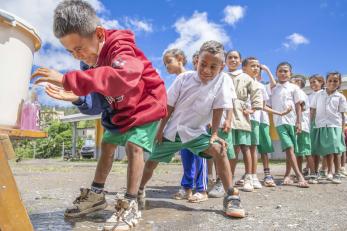
Since 2023, the primary school in Maubisse Villa, Timor-Leste has been working with Mercy Corps to boost the well-being of students. Faculty and students receive training on nutrition, health, and hygiene. A highlight of the programme has helped the school stock up on and cook up more varied and healthy lunches, that include meat, eggs, tofu, and tempeh. The children have more energy and school attendance has increased, in part because students know they’ll receive a nutritious meal at school. This year, Mercy Corps has reached over 1.1 million people with programming that delivers training on and highlights the importance of nutrition.
I spent the better part of an afternoon following this happy cohort of students around their sunny schoolyard, as they played games learning about nutrition and health. This line of kids waiting to wash their hands before lunch was my favorite part, as they enthusiastically encouraged each other and laughed as they took their turn, proud to demonstrate what they had learned.
*Names has been changed to protect participant privacy

